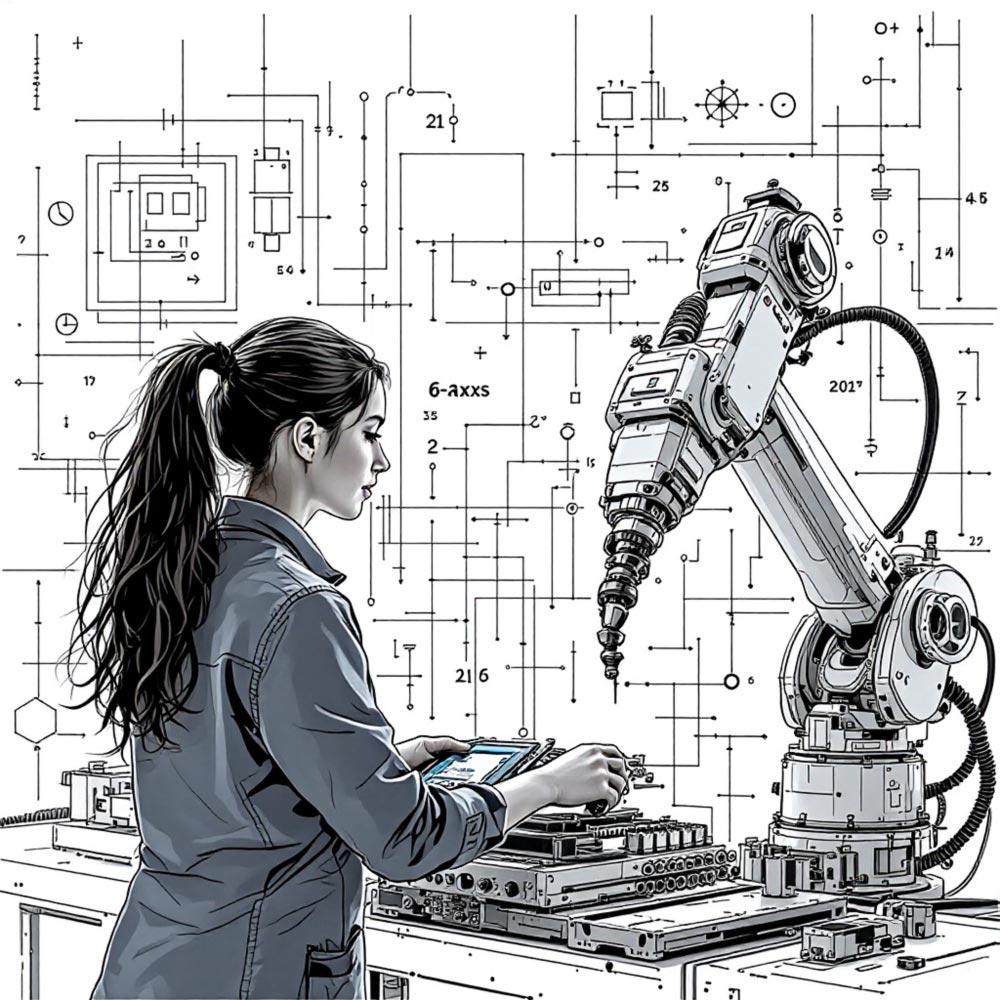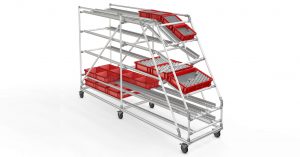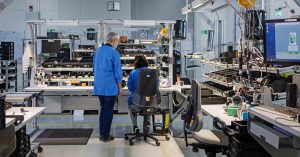What does successful production planning look like in practice? Expert Kai Stindt explains the success factors, challenges and solutions for manufacturing companies.
Production planning – an interview with expert Kai Stindt
– Production planning ensures efficient design and controlling of manufacturing processes.
– It covers the planning of volumes, schedules, capacities and factory equipment.
– The aim is to achieve cost-effective, smooth production operations through optimised utilisation of resources.
– The technical solution should only be developed once you have a complete understanding of the process.
– One common mistake is focusing too much on investment costs rather than on production costs per piece.
– The human factor means constructive communication and collaboration are key to the success of the project.
– When it comes to implementing projects, it is advisable to work together with a network of experts such as the item pluspartners.

Kai Stindt is the founder and managing director of ENABLE Production Consulting UG & Co. KG. He has been working in the fields of automation and specialist mechanical engineering for over 30 years, focusing on planning and consulting in relation to all aspects of the development of assembly processes and automation equipment. Early on, he set up his own company, PLAN B, which is an item pluspartner. With ENABLE Production Consulting, Stindt now offers holistic, independent support for manufacturing companies – from production strategies to advice on operational organisation. His decades of experience make him the ideal person to interview about production planning.
Definition – what is production planning?
Production planning is a process within production management that focuses on the efficient design and control of manufacturing processes. It includes the planning of volumes, schedules, capacities and resources to optimise the organisation of product manufacturing or service provision. The aim is to ensure production operations are both smooth and cost-efficient, by forecasting demand and using resources effectively.
Lean production and production planning are closely linked. In the item Academy, you will find numerous online training courses covering the basics of lean production. The online training unit on one-piece flow, for example, will show you how you can cut throughput times in manual production by as much as 80 percent. Shorter throughput times boost productivity, cut costs and increase product quality. To use the item Academy, all you need is an item user account.
Production planning in practice
Mr. Stindt, what is your approach to production planning?
“For me, production planning always starts with the product. That means I start by analysing the product in terms of how it can be assembled, and I take a look at the assembly process. I do this by creating a priority chart and examining the project specifications very carefully. These include aspects such as the number of pieces and the environment in which the system is to be created. All these conditions, including the product KPIs or characteristics, provide the basis for the planning.
To me, the most important thing is to gain a complete understanding of the process. Only then do I develop the appropriate technical solution. Some customers expect to be presented with a finished solution immediately. However, as an independent consultant, my goal is to find the solution with the fewest compromises.”
Are there any frequent misconceptions you come across regarding production planning?
“In addition to technical and organisational aspects, I also take economic factors into consideration. In my view, there is often too much focus on pure investment costs and too little on the production costs per piece.
The aim should be to keep the production costs per piece as low as possible – in other words, don’t just think about how much money is available at the moment. After all, investment costs are only a minor factor in calculating cost-effectiveness.”
In my view, there is often too much focus on pure investment costs and too little on the production costs per piece.
How do you support the implementation of a project?
“There are various options. The typical way is for me to work with the client in developing the specifications. These include every detail from the technical description and commercial framework to tools and organisational topics. Once these have been drawn up, you can go to the market and enquire about the equipment. In many cases, most of my work is done at this point.
Another possibility is that I continue to support the project in the tendering phase, acting as a neutral consultant. I then compare quotations and participate in negotiations with bidders. It is also possible that I might provide support throughout the entire construction phase, advising the client all the way to the start of production.
There are very few projects where I am involved from start to finish. Frequently, I come on board with projects when they are already in the implementation phase. I then support them for some of the way.
Another variant is collaboration with partner companies such as those in the item pluspartner network.”
Cooperation between partners as a key to success
As a former item pluspartner, you must be very familiar with the profile technology from item. What do you feel are the key benefits?
“The possibilities offered by the item portfolio are excellent. In addition, item provides outstanding service and is a reliable partner.
In addition to conventional aluminium profiles, there are plenty of other things to discover at item – the range is huge. A lot of development work goes into this. It’s always fascinating when the new products come out.
If the client hasn’t already specified a manufacturer, it goes without saying that I recommend item as a partner for profile technology. Depending on the project, I might also recommend involving item pluspartners. I’m happy to make the initial contact.”
The possibilities offered by the item portfolio are excellent. In addition, item provides outstanding service and is a reliable partner.
How important are collaborations for you fundamentally?
“This is a vitally important factor for me. In this context, I differentiate between ‘network’ and ‘consortium’. I understand a network as being something where you know the other people in the network and recommend them when a suitable project comes up. I’m happy to do that.
For ENABLE Production Consulting, I’m looking to build up a consortium. What I mean by that is a group of different experts with complementary skills working in concert. Everyone does what they do best. This all falls under the heading of ‘manufacturing company’.
If I see that something is not in my field of expertise, I know I can bring in someone from the consortium who will be exactly what’s needed for the whole thing. That might be logistics planning, for example. In the same way, the logistics expert will recommend my services when it comes to planning an assembly system. There’s no legal framework for our cooperation, but it is shaped by mutual trust and obligation. It’s about having set partners who work together regularly.”
Production planning between expertise and innovation
Which skills and characteristics help you in your work?
“I think I am very good at finding solutions, even for industries that I don’t initially know much about. Part of this is that I am good at putting things together quickly thanks to my ability to think in abstract terms, combinatorics, and my decades of experience.
I critically examine existing processes and check whether they are really necessary. My outsider’s perspective enables me to contribute new momentum and ideas, independent of familiar structures.”
Which factor do you think is often underestimated in production planning?
“The human factor is certainly key. It is rarely technical problems that cause projects to fail. Challenges in human interactions are much more significant.
External consultants are good at untangling knots in complex situations and redirecting focus onto the technical level. It’s not about attributing blame, but rather about the goals of the project.
Ultimately, you have to take both things into consideration – technology and topics such as operational organisation and communication. That’s one of my top priorities at ENABLE Production Consulting.”
External consultants are good at untangling knots in complex situations and redirecting focus onto the technical level.
Are there current trends that are of particular interest to you?
“I’m fundamentally wary when it comes to trends. The solution must always fit the challenge. The technology of automated guided vehicles (AGVs) and autonomous mobile robots (AMRs) has really come on in leaps and bounds. Application could still become much more straightforward. They can really be beneficial, perhaps also in combination with cobots.
Another interesting subject is AI solutions. Not only does this make software programming much easier, but I can also imagine that AI applications will bring process planning a key step forwards.”

Frequently asked questions about production planning
What are the goals of production planning?
The aim of production planning is to ensure efficient, smooth production – use of resources such as materials, machinery and staff must be optimised to meet customer demand. Other goals include minimising costs, meeting delivery deadlines, avoiding bottlenecks and boosting productivity.
What aspects are covered by production planning?
It includes the planning of volumes, schedules, capacities and factory equipment.
Why should technical solutions only be developed once you have a complete understanding of the process?
It is only when you have a comprehensive understanding of the entire process that you can find a technical solution with the fewest possible compromises.
What is a common mistake in production planning?
There is often too much focus on investment costs, while production costs per piece are not given enough consideration.
What are the current trends influencing production planning?
Technologies such as automated guided vehicles (AGVs), autonomous mobile robots (AMRs) and AI offer new opportunities for production. However, these kinds of solutions must always fit the respective challenge.





